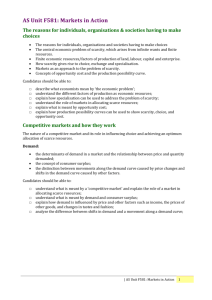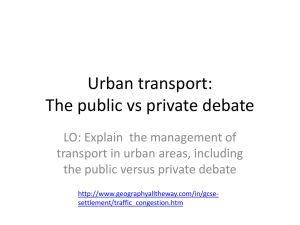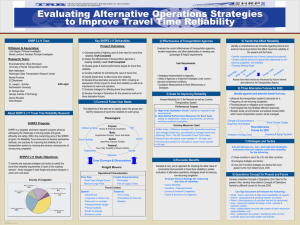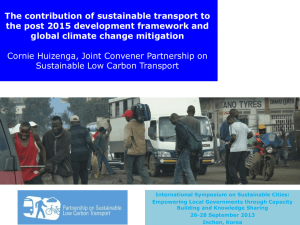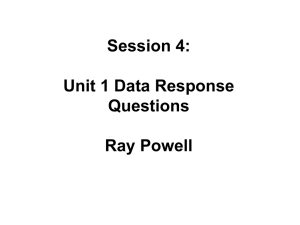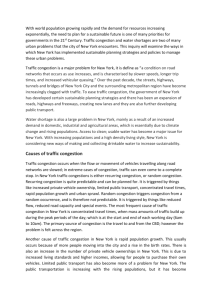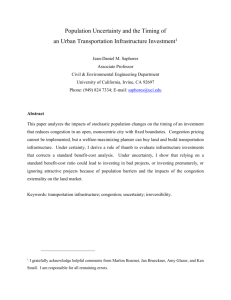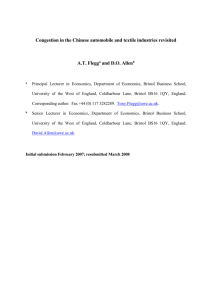Transport Economics
advertisement
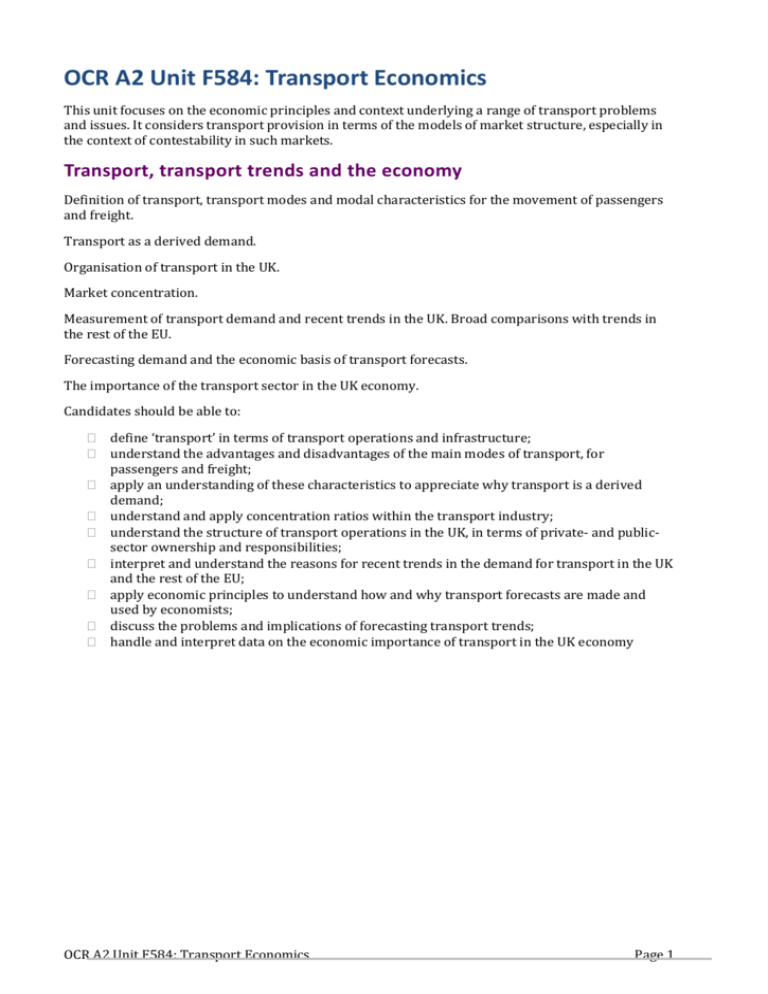
OCR A2 Unit F584: Transport Economics This unit focuses on the economic principles and context underlying a range of transport problems and issues. It considers transport provision in terms of the models of market structure, especially in the context of contestability in such markets. Transport, transport trends and the economy Definition of transport, transport modes and modal characteristics for the movement of passengers and freight. Transport as a derived demand. Organisation of transport in the UK. Market concentration. Measurement of transport demand and recent trends in the UK. Broad comparisons with trends in the rest of the EU. Forecasting demand and the economic basis of transport forecasts. The importance of the transport sector in the UK economy. Candidates should be able to: define ‘transport’ in terms of transport operations and infrastructure; understand the advantages and disadvantages of the main modes of transport, for passengers and freight; apply an understanding of these characteristics to appreciate why transport is a derived demand; understand and apply concentration ratios within the transport industry; understand the structure of transport operations in the UK, in terms of private- and publicsector ownership and responsibilities; interpret and understand the reasons for recent trends in the demand for transport in the UK and the rest of the EU; apply economic principles to understand how and why transport forecasts are made and used by economists; discuss the problems and implications of forecasting transport trends; handle and interpret data on the economic importance of transport in the UK economy OCR A2 Unit F584: Transport Economics Page 1 Market structures The costs and revenues of firms: total concept; average concept; marginal concept. Short- and long-run distinction. Economies of scale. Firms’ objectives: profit maximisation; alternative objectives The concept of an efficient market structure in terms of costs, prices, output and profit Candidates should be able to: □ □ □ □ □ □ □ understand the nature of costs in the short and long run; understand the nature of, and influences on, firms’ revenues; explain what is meant by economies and diseconomies of scale and how firms might be affected by these; explain the models of market structure: monopoly, oligopoly, monopolistic competition evaluate the relative efficiency of these market structures in theory and practice; analyse the natural monopoly argument applied to transport; explain what is meant by contestability and the characteristics of a perfectly contestable market; Competitive behaviour in transport markets The models of market structure: monopoly; oligopoly; monopolistic competition. The concept of contestability in markets. Comparison of outcomes in these different market structures. Application of models of market structures to transport markets. Concentration Ratio. Importance of barriers to entry in determining the degree of competition and contestability in selected transport markets. Efficiency considerations. Natural monopoly argument. Transport markets: deregulation; franchising; privatisation Candidates should be able to understand: discuss the extent to which particular transport markets are contestable; explain what is meant by deregulation and franchising; evaluate the impact of deregulation in selected transport markets; discuss the arguments for and against the privatisation of transport services; evaluate the impact of privatisation on rail passenger and freight services; understand and apply; discuss the objectives and behaviour of firms in transport markets 2 Market structures | Market failure and the role of intervention in transport markets Negative externalities associated with increased transport use and how these may be expressed in monetary terms: pollution; noise; accidents; blight; stress; congestion. Transport and the environment – the impact of an increasing use of road and air transport especially. Role of regulation, indirect taxation and subsidies in dealing with negative externalities and the use of fuel; the hypothecation of taxation. The nature and meaning of sustainability in transport modal comparisons and how to achieve more sustainable outcomes. Traffic congestion as a case of market failure. Costs of congestion. Approaches for dealing with congestion. Road pricing and congestion charging: advantages and disadvantages. International comparisons of policies for reducing congestion in cities. Candidates should be able to: describe the negative externalities associated with increased transport use; explain how and why economists seek to put a monetary value on these negative externalities; discuss the problems and implications of placing monetary values on negative externalities; explain the effects of the increased demand for road and air transport on the environment; analyse why the existence of negative externalities is a case of market failure; discuss the role of the following in cases of market failure: o regulation, o indirect taxation, o subsidies; understand what is meant by sustainability in transport; discuss the extent to which some modes of transport are more sustainable than others; explain why traffic congestion is a classic example of market failure; discuss the broad approaches for dealing with congestion; understand what is meant by road pricing, including congestion charging; discuss the extent to which road pricing is an effective way of dealing with market failure associated with traffic congestion; discuss the impact on UK towns and cities and elsewhere in the world where road- pricing schemes have been implemented; discuss, using case studies of developed and emerging economies, how other countries have sought to deal with the problems of urban traffic congestion. | Market failure and the role of intervention in transport markets 3 Transport economics and government policy How resources are allocated in transport. Role of public and private sectors in resource allocation decisions. Cost-benefit analysis – the need for a cost-benefit approach for allocating resources and its application. Negative and positive externalities associated with transport use. Road space as a quasi-public good and as a private good. Limitations of a cost-benefit approach. Changing approaches to road appraisal. Comparison of costbenefit and commercial approaches. Opportunities for private-sector investment in transport. Transport policy. Objectives, nature and features of an integrated transport policy. Current UK transport policies – a perspective on how government policy is seeking to achieve the best allocation of resources. Future considerations – how to meet future demand. Significance of a more sustainable transport policy. Candidates should be able to: understand the role of public and private sectors in resource allocation in transport; explain what is meant by cost-benefit analysis; explain why cost-benefit analysis is needed in the case of investment decisions for new road schemes; discuss the limitations of the cost-benefit approach and recent modifications to the methodology; discuss how the cost-benefit approach compares with private sector methods of appraisal; explain what is meant by integration in transport policy; discuss how transport policy seeks to deal with current transport problems and issues, such as congestion, in the UK and elsewhere; discuss how transport policy can meet future needs and requirements, including recent EU policy initiatives in areas such as freight transport. Assessment 25% of the total Advanced GCE marks. 2h written paper. 60 marks This question paper has two sections: Section A: Candidates are required to answer one mandatory data-response question. Section B: Candidates are required to answer one structured question from a choice of three. Each structured question is split into two parts. Candidates answer two questions in total. This unit is synoptic 4 Transport economics and government policy |

